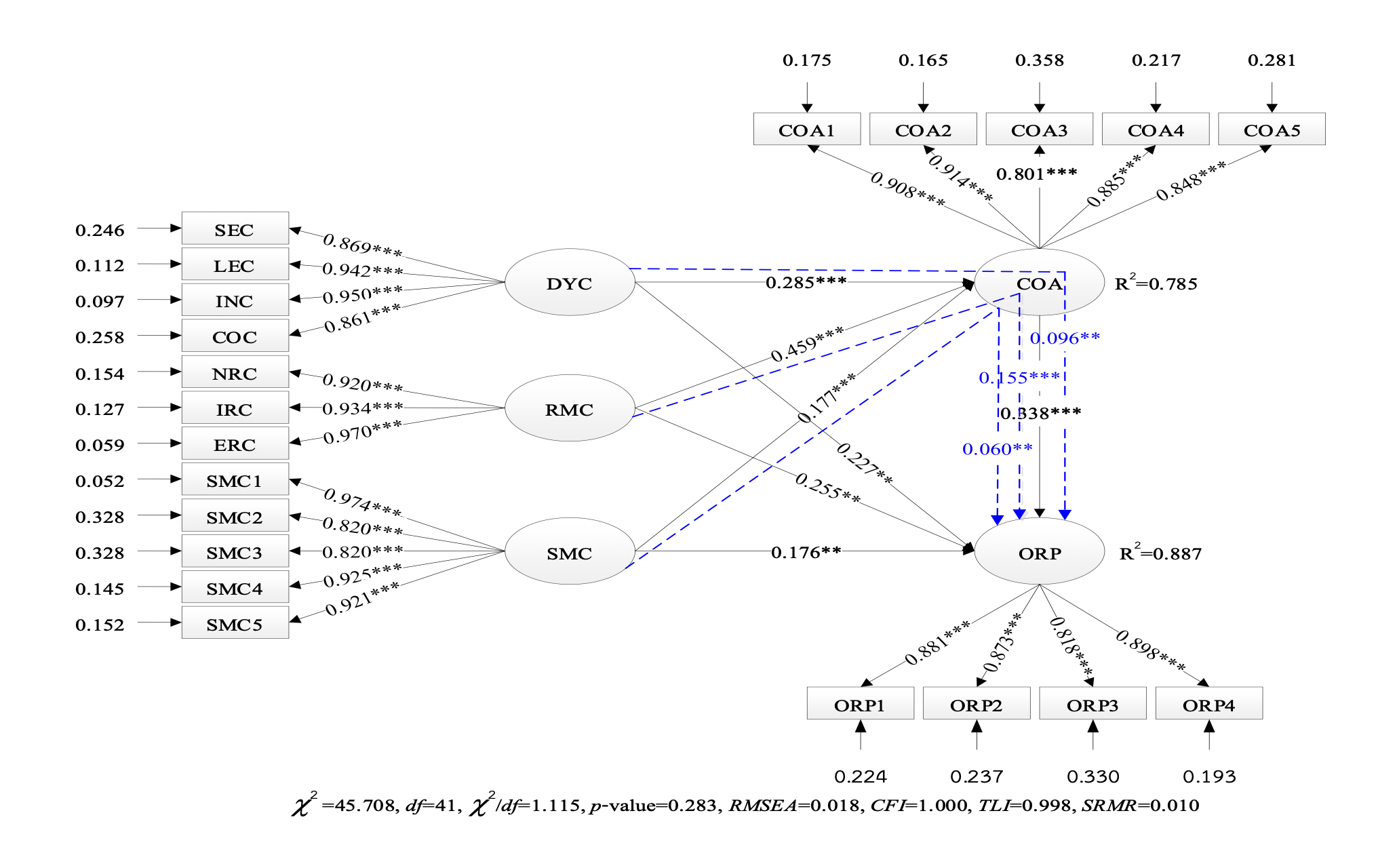ปัจจัยที่มีอิทธิพลต่อผลการดำเนินงานขององค์การสมาชิกสมาคมค้าทองคำรูปพรรณในประเทศไทย
Main Article Content
บทคัดย่อ
การวิจัยครั้งนี้มีวัตถุประสงค์เพื่อ 1) ศึกษาความสามารถเชิงพลวัต ความสามารถในการบริหารความเสี่ยง และความสามารถในการบริหารซัพพลายเออร์ที่ส่งผลทางตรงต่อความได้เปรียบในการแข่งขันขององค์การสมาชิกสมาคมค้าทองคำรูปพรรณในประเทศ 2) ศึกษาความสามารถเชิงพลวัต ความสามารถในการบริหารความเสี่ยง ความสามารถในการบริหารซัพพลายเออร์ และความได้เปรียบในการแข่งขันที่ส่งผลทางตรงต่อผลการดำเนินงานขององค์การสมาชิกสมาคมค้าทองคำรูปพรรณในประเทศ 3) ศึกษาความสามารถเชิงพลวัต ความสามารถในการบริหารความเสี่ยง และความสามารถในการบริหารซัพพลายเออร์ที่ส่งผลทางอ้อมต่อผลการดำเนินขององค์การงานผ่านทางความได้เปรียบในการแข่งขันขององค์การสมาชิกสมาคมค้าทองคำรูปพรรณในประเทศ และ 4) ตรวจสอบความสอดคล้องของโมเดลความสัมพันธ์เชิงสาเหตุปัจจัยที่มีอิทธิพลต่อผลการดำเนินงานขององค์การสมาชิกสมาคมค้าทองคำรูปพรรณในประเทศไทยกับข้อมูลเชิงประจักษ์ เป็นการวิจัยเชิงปริมาณ ใช้แบบสอบถามเป็นเครื่องมือในการเก็บรวบรวมข้อมูลจากตัวแทนองค์การสมาชิกสมาคมค้าทองคำรูปพรรณในประเทศไทย จำนวน 358 คน ด้วยวิธีการสุ่มแบบหลายขั้นตอน สถิติที่ใช้ในการวิเคราะห์ข้อมูล ได้แก่ การหาค่าจำนวน การหาค่าร้อยละ การหาค่าเฉลี่ย การหาค่าเบี่ยงเบนมาตรฐาน และการวิเคราะห์สมการโครงสร้าง
ผลการวิจัยพบว่า
1) ความสามารถเชิงพลวัต ความสามารถในการบริหารความเสี่ยง และความสามารถในการบริหารซัพ
พลายเออร์มีอิทธิพลทางตรงเชิงบวกต่อความได้เปรียบในการแข่งขัน
2) ความสามารถเชิงพลวัต ความสามารถในการบริหารความเสี่ยง ความสามารถในการบริหารซัพพลายเออร์ และความได้เปรียบในการแข่งขันมีอิทธิพลทางตรงเชิงบวกต่อผลการดำเนินงานขององค์การ
3) ความสามารถเชิงพลวัต ความสามารถในการบริหารความเสี่ยง และความสามารถในการบริหารซัพพลายเออร์ส่งผลทางอ้อมเชิงบวกต่อผลการดำเนินงานขององค์การผ่านทางความได้เปรียบในการแข่งขันขององค์การ
4) โมเดลสมการโครงสร้างสอดคล้องกับข้อมูลเชิงประจักษ์ โดยมีค่าไค-สแควร์มีค่าเท่ากับ 45.708 ค่าองศาอิสระ (df) มีค่าเท่ากับ 41 ค่าไค-สแควร์สัมพัทธ์มีค่าเท่ากับ 1.115 ค่า p-value มีค่าเท่ากับ 0.283 ค่าดัชนีค่าความคลาดเคลื่อนในการประมาณค่าพารามิเตอร์ (RMSEA) มีค่าเท่ากับ 0.018 ค่าดัชนีวัดความกลมกลืนเปรียบเทียบ (CFI) มีค่าเท่ากับ 1.000 ค่าดัชนีทักเกอร์เลวิส (TLI) มีค่าเท่ากับ 0.998 และค่ารากที่สองของค่าเฉลี่ยกำลังสองของส่วนเหลือ (SRMR) มีค่าเท่ากับ 0.010
Article Details

อนุญาตภายใต้เงื่อนไข Creative Commons Attribution-NonCommercial-NoDerivatives 4.0 International License.
** ข้อความ ข้อคิดเห็น หรือข้อค้นพบ ในวารสารสหวิทยาการสังคมศาสตร์และการสื่อสารเป็นของผู้เขียน ซึ่งจะต้องรับผิดชอบต่อผลทางกฎหมายใด ๆ ที่อาจเกิดขึ้นจากบทความและงานวิจัยนั้น ๆ โดยมิใช่ความรับผิดชอบของคณะนิเทศศาสตร์ มหาวิทยาลัยราชภัฏรำไพพรรณี **
เอกสารอ้างอิง
นิตยา โพธิ์ศรีจันทร์ และศิริวรรณ เพชรไพร. (2565). ผลกระทบของการประยุกต์ใช้ข้อมูลการบัญชีบริหารเชิงรุกที่มีต่อประสิทธิภาพการดําเนินงานของธุรกิจขนาดกลางและขนาดย่อม ในจังหวัดนครพนม. วารสารศิลปศาสตร์และวิทยาการจัดการ, 9(1), 19-30.
นิลุบล วิโรจน์ผดุงพงศ์ สวียา ปรารถนาดี และอนิรุธ พิพัฒน์ประภา. (2563). ปัจจัยเชิงสาเหตุของความสามารถการจัดการห่วงโซ่อุปทานด้านสิ่งแวดล้อมที่มีต่อผลการดำเนินงานอย่างยั่งยืนของอุตสาหกรรมโรงแรมในประเทศไทย. วารสารวิชาการบริหารธุรกิจสมาคมสถาบันอุดมศึกษาเอกชนแห่งประเทศไทย, 9(1), 154-173.
สมาคมค้าทองคำ. (2565). ดัชนีราคาทอง เดือน พ.ค. 65 ผู้ค้าเห็นตรงกับนักลงทุน กังวลนโยบายดอกเบี้ย FED กดดันราคาทอง. สืบค้นจาก https://www.goldtraders.or.th/ArticleView.aspx?gp= 1&id=1194
สมาคมค้าทองคำ.(2565b). รายชื่อสมาชิกสมาคมค้าทองคำ แบ่งตามรายจังหวัด. สืบค้นจาก https://www.goldtraders.or.th/MemberZones.aspx
Altincubuk, B. (2022). Jewerly sector within the persectives of transaction cost and network approaches: informality and economic adventage Ufuk Üniversitesi Sosyal Bilimler Enstitüsü Dergisi, 11(21), 57-69.
Baporikar, N. (2019). Factors Creating Competitive Advantage for Family-Owned Business. In J. M. Saiz-Alvarez (Ed.), Handbook of Research on Digital Marketing Innovations in Social Entrepreneurship and Solidarity Economics (pp. 47-62). Hershey, PA: IGI Global.
Barney, J. B. (1991). Firm resources and sustained competitive advantage. Journal of Management, 17(1), 99-120. doi:10.1177/014920639101700108
Best, J. W. (1982). Research in education (4 ed.). Prentice Hall.
Boucherf, K., & Medjoub, R. (2022). Gold Sellers in the Streets of Bachdjerrah: El Houma: Community Identity and Globalised Economic Territory. Youth and Globalization, 3(2), 332-358.
Correia, R. J., Dias, J. G., & Teixeira, M. S. (2020). Dynamic capabilities and competitive advantages as mediator variables between market orientation and business performance. Journal of Strategy and Management, 14(2), 187-206.
Hair, J. F., Babin, B. J., Anderson, R. E., & Black, W. C. (2019). Multivariate data analysis (8th ed.). India: Cengage.
Holma, A.-M., Østensen, M. W., Holmen, E., & de Boer, L. (2022). Market dialogue in public procurement: Buyer-supplier interfaces and relational abilities. Industrial Marketing Management, 104, 51-67. doi:https://doi.org/10.1016/j.indmarman.2022.04.004
INN News. (2021). Why gold is important to the economy (and us). Retrieved from https://www.innnews.co.th/finance/news_30219/
Joureih, M. (2019). Human Capital Development. In B. C. Thomas & L. J. Murphy (Eds.), Innovation and social capital in organizational ecosystems (pp. 132-150). Hershey, PA: IGI Global.
Li, D.-y., & Liu, J. (2014). Dynamic capabilities, environmental dynamism, and competitive advantage: Evidence from China. Journal of Business Research, 67(1), 2793-2799. doi:https://doi.org/10.1016/j.jbusres.2012.08.007
Li, S., & Chen, X. (2019). The role of supplier collaboration and risk management capabilities in managing product complexity. Operations Management Research, 12(3), 146-158.
Muna, N., Yasa, N., Ekawati, N., & Wibawa, I. (2022). A dynamic capability theory perspective: borderless media breakthrough to enhance SMEs performance. International Journal of Data and Network Science, 6(2), 363-374.
Park, M., & Singh, N. P. (2023). Predicting supply chain risks through big data analytics: role of risk alert tool in mitigating business disruption. Benchmarking: An International Journal, 30(5), 1457-1484. https://doi.org/10.1108/BIJ-03-2022-0169
Pavlou, P. A., & El Sawy, O. A. (2011). Understanding the elusive black box of dynamic capabilities. Decision Sciences, 42(1), 239-273.
Phangestu, J., Kountur, R., & Prameswari, D. A. (2020). The moderating effect of entrepreneurial leadership and competitive advantage on the relationship between business model innovation and startup performance. Journal of Business and Retail Management Research, 14(3), 53-61.
Prabowo, H., Sriwidadi, T., & Ikhsan, R. B. (2021). The Influence of Dynamic Capability on Sustainable Competitive Advantage: An Empirical Study of Small Businesses in Indonesia. The Journal of Asian Finance, Economics and Business, 8(6), 949-959.
Rejikumar, G., Fatih, C., Devi, M., Rahman, U. H., Das, S., Abotaleb, M., & Mishra, P. (2021). Structural analysis of Indian gold exports: perspectives for trade policy development. J. Math. Comput. Sci., 11(4), 4042-4066.
Saghiri, S. S., & Mirzabeiki, V. (2021). Buyer-led environmental supplier development: Can suppliers really help it? International Journal of Production Economics, 233, 107969. doi:https://doi.org/10.1016/j.ijpe.2020.107969
Sunargo, S. (2022). The Role of Entrepreneurship Orientation and Competitive Advantage as Strategy to Improve MSME Performance Post Covid-19 Pandemic in Batam City. Sustainability: Theory, Practice and Policy, 2(1), 44-59.
Teece, D. J., Pisano, G., & Shuen, A. (1997). Dynamic capabilities and strategic management. Strategic management Journal, 18(7), 509-533.
Thongchuay. (2021). What is gold? Retrieved from https://thongchuay.co/gold-stories/goldbar/ goldtoday-what-is-gold/6120
U-Tantada, S. (2019). Influential driving factors for corporate performance: A case of small and medium enterprises in Thailand. Doctor of Philosophy (Business Adminstration), Ramkhamhaeng University, Bangkok, Thailand.
Wang, L., Wang, P., & Zeng, X. (2021). The role of industrial digitization in modularized supply chain management. Paper presented at the 2021 10th International Conference on Software and Computer Applications (pp. 213-218).
Wang, M. W. C., Tan, C. L., & Wahid, N. A. (2020). Supplier management practice and service quality: critical review on mediating role of outsourcing service provider capabilities International Journal of Industrial Management, 7, 9-15.
Yamin, S., Gunasekaran, A., & Mavondo, F. T. (1999). Relationship between generic strategies, competitive advantage and organizational performance: an empirical analysis. Technovation, 19(8), 507-518. doi:https://doi.org/10.1016/S0166-4972(99)00024-3
Zheng, J., Khurram, M. U., & Chen, L. (2022). Can Green Innovation Affect ESG Ratings and Financial Performance? Evidence from Chinese GEM Listed Companies. Sustainability, 14(14), 8677.


